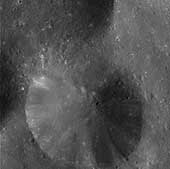|
COMETS EARTH JUPITER KUIPER BELT MARS MERCURY METEORITES NEPTUNE OORT CLOUD PLUTO SATURN SOLAR SYSTEM SPACE SUN URANUS VENUS ORDER PRINTS
PHOTO CATEGORIES SCIENCEVIEWS AMERICAN INDIAN AMPHIBIANS BIRDS BUGS FINE ART FOSSILS THE ISLANDS HISTORICAL PHOTOS MAMMALS OTHER PARKS PLANTS RELIGIOUS REPTILES SCIENCEVIEWS PRINTS
|
Related Documents
Download Options
This eye-popping high-resolution image of Phoebe's pitted surface taken very near closest approach shows a 13-kilometer (8-mile) diameter crater with a debris-covered floor. Part of another crater of similar size is visible at left, as is part of a larger crater at top and many scattered smaller craters. The radial streaks in the crater are due to down slope movements of loose fragments from impact ejecta. Also seen are boulders ranging from about 50 to 300 meters (160 to 990 feet) in diameter. The building-sized rocks may have been excavated by large impacts, perhaps from some other region of Phoebe rather than the craters seen here. There is no visible evidence for layering of ice and dark material or a hardened crust in this region, as on other parts of this moon. Some of the relatively bright spots are from small impacts that excavated bright material from beneath the dark surface. Images like this provide information about impact processes on Phoebe. This image was obtained at a phase, or Sun-Phoebe-spacecraft, angle of 78 degrees, and from a distance of 11,918 kilometers (7,407 miles). The image scale is approximately 18.5 meters (60.5 feet) per pixel. The illumination is from the right. No enhancement was performed on this image. |
